It’s the season for fruits in the garden! In Central Texas, warm weather is the time to plant tomatoes, peppers, melons, squash, cucumber, okra, and eggplant, among other fruit crops.
In order for most of our garden plants to provide us with a successful crop, they (and we!) need help from pollinators. The most famous pollinator is the beloved, industrious European honeybee. But along with the honeybee, a plethora of other creatures offer their pollination services to plants as they busily collect nectar and pollen. Butterflies, moths, bats, beetles, flies, and others are important pollinators. But because they often get overshadowed by the honeybee, this week Grow Local would like to shine a light on some of the fascinating and diverse native bees of North America.
Native bees come in a huge variety of shapes, sizes, and colors, and have an amazing variety of nesting styles. Because they are adapted to collect nectar and pollen from native plant species, in some cases, native bees are even more efficient pollinators than honeybees. For example, North American bumblebees buzz in order to release pollen from members of the nightshade family (which includes, tomatoes, peppers, and eggplants), which is native to the Americas. This means bumblebees to a better job of pollinating tomatoes and peppers than honeybees do. All this to say that it is worthwhile to learn a bit about our native pollinators, and to welcome them into our gardens alongside the honeybee!
For the beginning native bee-watcher, here are six bee families found in North America, and a few facts about each:
- Polyester Bees (Colletidae) - These bees line the brood cells where they raise their young with a very strong cellophane-like substance, hence their name. This makes their underground nests waterproof enough for their nests to survive in flood-prone areas.
- Mining Bees (Andrenidae) - This is the most diverse family of bees on our continent. All bees in this family dig their burrows into the ground, usually on flat or slightly sloping sites. Most, but not all, bees in the Andrenidae family are solitary bees, meaning that females nest and raise young alone.
- Sweat Bees (Halictidae) - This family includes brightly colored metallic bees, though most are dull-colored and small. See if you can spot an iridescent green small sweat bee common in our region.
- Leafcutter and Mason Bees (Megachilidae) - Instead of carrying pollen on their legs, these bees collect it on the the stiff hairs underneath their abdomens. Bees in the Megachilidae family nest in existing gaps in stems, wood, or rocks, and use chewed-up leaves, petals, or mud to divide their nests into brood cells for young.
- Bumble, Carpenter, and other bees (Apidae) - This family is extremely diverse, and includes species with many types of nesting behaviors. Honeybees, though not native to North America, are members of this family. Some members of this family are cleptoparasitic, meaning they steal the burrows of other bees!
- Oil-Collecting Bees (Melittidae) - This is a small family of bees, with only a few types found in North America. All bees in the Melittidae family nest in the ground, and all are solitary. The family is named for one genus, Macropis, which collects oils from a particular type of flower to line its brood cells.
How can you make your home, school, or community garden native bee-friendly? Try the following:
- Designate an area for planting species our native bees love. Unsurprisingly, native bees love the flowers of native plant species. Favorites include: Beebalm, California poppy, Purple coneflower (Echinacea), spiderwort, yarrow, sunflower, False indigo, as well as the Redbud tree. For more species, visit the Ladybird Johnson Wildflower Center’s extensive list.
- Choose a combination of plants that bloom at different times of year, so bees have ready access to food throughout the year. Plant at least three species that bloom in each season. A bonus: you’ll enjoy year-round displays of colorful flowers.
- When possible, place pollinator-attracting plants in open, sunny areas, as most bees prefer this type of foraging environment.
- Group together sections of the same type of pollinator-attracting plant, since bees are attracted to large blocks of color, and this helps them forage most efficiently.
- NEVER use chemical pesticides, herbicides, or fungicides.
One last way you can support our native bee population is to protect their nesting habitat. To do this:
- Leave a few bare (unmulched) patches of soil for bees that nest underground. We recommend doing this somewhere outside your garden beds, which should always be well mulched.
- Allow some dead foliage, particularly shrubs with hollow stems, to remain undisturbed on your site, so mason and leafcutter bees can nest inside.
Best of luck with pollination this season, and three cheers for our native bees!
Much of the information from this article is taken from The Xerces Society’s guide, Attracting Native Pollinators. Check it out for more information about native pollinators!

